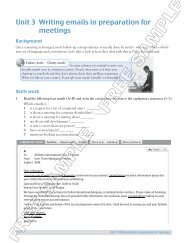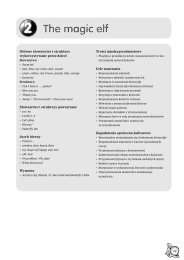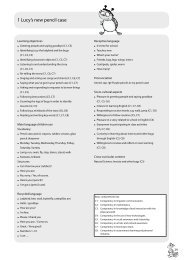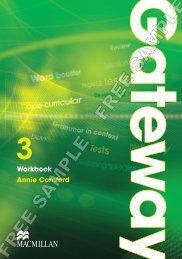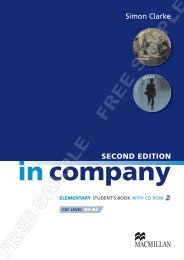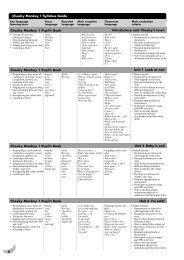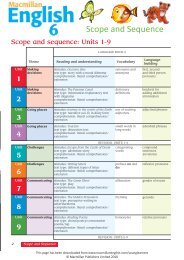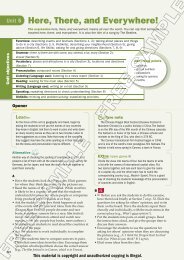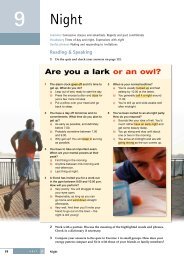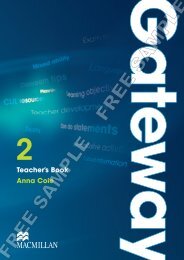9 In my life - Macmillan
9 In my life - Macmillan
9 In my life - Macmillan
Create successful ePaper yourself
Turn your PDF publications into a flip-book with our unique Google optimized e-Paper software.
9 <strong>In</strong> <strong>my</strong> <strong>life</strong><br />
Grammar<br />
• present perfect: ever, never<br />
Vocabulary<br />
• experiences<br />
Optional materials<br />
• sheets of A4 paper, one fewer than there are<br />
students in class<br />
LESSON 9a<br />
<strong>In</strong>troduction<br />
Copy the following table onto the board:<br />
Places we visit<br />
on holiday<br />
Forms of<br />
transport<br />
Unusual<br />
food<br />
Kinds of<br />
music<br />
Put students into groups of four and ask them to write as many<br />
words in each category as possible. Set a time limit of four<br />
minutes. Elicit the words from different groups onto the board and<br />
then compare how many of them appear in Activity 1 on page 30.<br />
1 Presentation<br />
a) [1.32] Focus students’ attention on the picture. <strong>In</strong>troduce<br />
Eva, the girl holding the poster with a poem. Ask students<br />
to listen and read Eva’s poem about her experiences. They<br />
should find the things she talks about in the pictures around<br />
the text. Play the CD.<br />
<strong>In</strong> pairs, students say which words from the poem the pictures<br />
illustrate. They should make guesses about new vocabulary.<br />
Point to the pictures in turn and elicit the words from the<br />
class. Make sure everybody understands all the words now.<br />
Explain any other vocabulary students may not understand.<br />
Refer students to the Grammar spot at the top of the next<br />
page to introduce the present perfect. Go over the example<br />
sentences and elicit or explain that we use the tense to talk<br />
about experiences without giving the specific time of the<br />
events. You can draw a timeline to illustrate this point (see<br />
the teaching tip below). Explain the structure of the present<br />
perfect and use the Remember! box to point out the full<br />
and short forms. Point out that regular verbs take the same<br />
form as in the past simple, but irregular verbs have a different<br />
form called the past participle. Demonstrate the past<br />
participle, using the list of irregular verbs on page 106. Refer<br />
students to the Grammar summary on page 101 for more<br />
information on the present perfect.<br />
Teaching tip: Timelines<br />
Timelines illustrate how tenses place events in time, and in<br />
relation to other events. They show complex rules in a simple<br />
visual way. The use of the present perfect is often a difficult<br />
concept for students. To clarify it, you can draw the following<br />
timeline:<br />
Explain that the cross marks a past event and the question<br />
mark shows that we do not know exactly when it happened.<br />
Optional Activity Book activities<br />
• Fast finishers p64, Extra practice p65<br />
Photocopiable activity<br />
• Experiences … p172<br />
Mixed-ability classes<br />
Fast fi nishers label the pictures in writing.<br />
Extra activity<br />
Check understanding of the poem by asking students to mark<br />
the pictures illustrating the things Eva has done in her <strong>life</strong><br />
with a tick (✔) and those she has not done with a cross (✘).<br />
Tapescript<br />
see Student’s Book Activity 1a<br />
b) [1.32] Play the CD again. Ask students to practise<br />
saying the poem aloud in chorus, then in pairs, helping<br />
each other with any pronunciation problems.<br />
Extra activity<br />
Encourage students to learn the poem by heart. They can use<br />
the following techniques: repetition/reading the poem several<br />
times, using the pictures to recall the complete lines, or cover<br />
every second or third word of the poem with blu-tack and<br />
then keep covering more words as they memorise the whole<br />
lines. Ask volunteers to recite the poem to the class.<br />
Teaching tip: Using poems in class<br />
Poems can serve a variety of purposes in the classroom.<br />
Primarily they are great tools to learn about the<br />
pronunciation of individual sounds and word stress.<br />
A lot of them follow a rhyming pattern. As students<br />
are listening to the poem, ask them to identify rhyming<br />
words. Before you ask students to work on the poem<br />
creatively, make sure they can read it well and hopefully<br />
memorise it, using different techniques. Ask students<br />
to first repeat the poem after you or the recording and<br />
then to practise reading it independently with fluency<br />
and expression, making use of the punctuation. Then<br />
they should read it to a classmate or in a group. Once<br />
students know the poem well, you can ask them to<br />
replace rhyming words with other rhyming words or write<br />
their own stanza following the pattern of the poem. This<br />
way students are encouraged to work on pronunciation<br />
and vocabulary, looking for words that rhyme with<br />
each other, as well as grammar, particularly tenses and<br />
sentence structure.<br />
Tapescript<br />
see Activity 1a<br />
T 30<br />
FREE SAMPLE FREE SAMPLE




